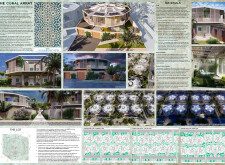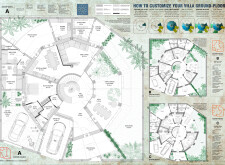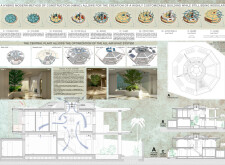5 key facts about this project
### Project Overview
Located within a natural context, "The Coral Array" employs a distinctive residential design strategy that merges aesthetic principles with functionality and sustainability. This project prioritizes community engagement and personalized living spaces through a modular design approach, facilitating varied residential needs.
### Conceptual Framework and Spatial Strategy
Rooted in the concepts of organic form and modularity, "The Coral Array" reflects the complexity and interconnectedness found in coral structures. The layout employs circular and octagonal motifs to promote inclusivity and connectivity among homes, thereby fostering a sense of community. The predominance of octagonal forms maximizes spatial efficiency while optimizing natural light and airflow. This flexible layout supports diverse living options, allowing for customization that aligns with individual preferences.
### Materiality and Sustainability Features
The project utilizes a carefully selected range of materials that enhance both functional and aesthetic values. Structural aluminum framing contributes to durability while maintaining a lightweight profile. Glass panels are integrated to provide unobstructed views and maximize daylight, further complemented by masonry elements that improve thermal efficiency. Composite wood finishes add warmth and design appeal, while strategically placed photovoltaic panels underscore a commitment to sustainability through solar energy harnessing. Environmental considerations are integrated into the design, featuring a centralized HVAC system and the use of local materials that promote passive climate control, making the project particularly suited for localized climate conditions.
In addition, outdoor spaces are incorporated throughout, including private gardens and communal areas that encourage interaction among residents and an engagement with nature. The division of shared amenities and landscaped walkways serves to enhance social dynamics within the community.






















































